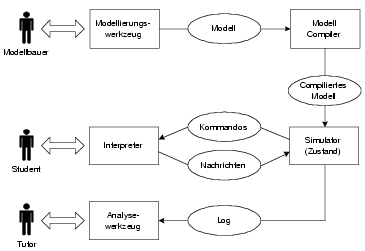The SESAM - System
From Ameise-en
The structure of the SESAM-system
The main objective of using SESAM is an almost realistic simulation of software projects for training purposes. Students should be able to apply their acquired knowledge playfully and deepen it on base of the simulation run.
Another aim is to make it possible to model unsecured hypotheses and study their consequences by replaying the simulation run. The SESAM-system is built of various components , which are used by different roles:
- modeler:
- He creates substantial empirical models that are simulated by the base machine. By the models, he determines which objects and relationships of a software project are mapped and what effects may occur. He thus defines the world in which the trainee can move.
- Trainee:
- The trainee takes the role of the project manager. He intervenes via commands in the course of the simulation run and receives messages about the current state of the system.
- Tutor:
- The tutor conducts training courses, at which the trainees participate. He not only leads the trainees, but also has the possibility to analyze the simulation runs through evaluation tools, to discuss the achieved results with the trainees.
The following figure shows the roles and their interaction with the components of the system.
